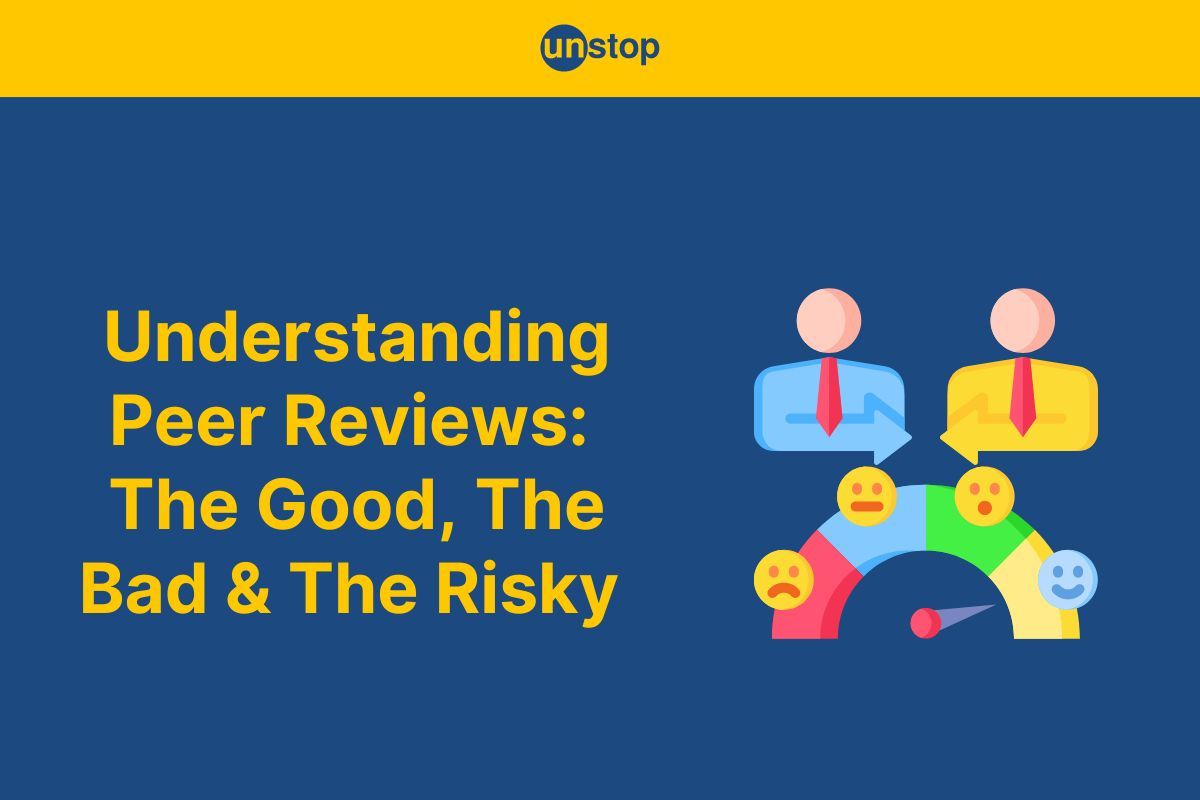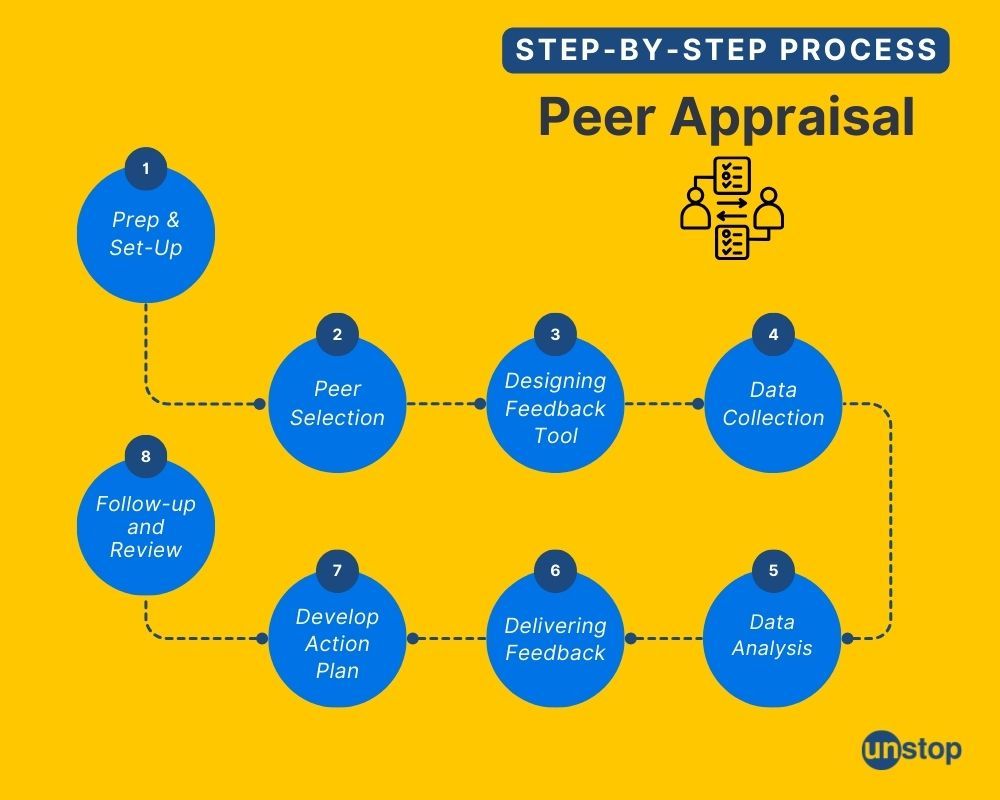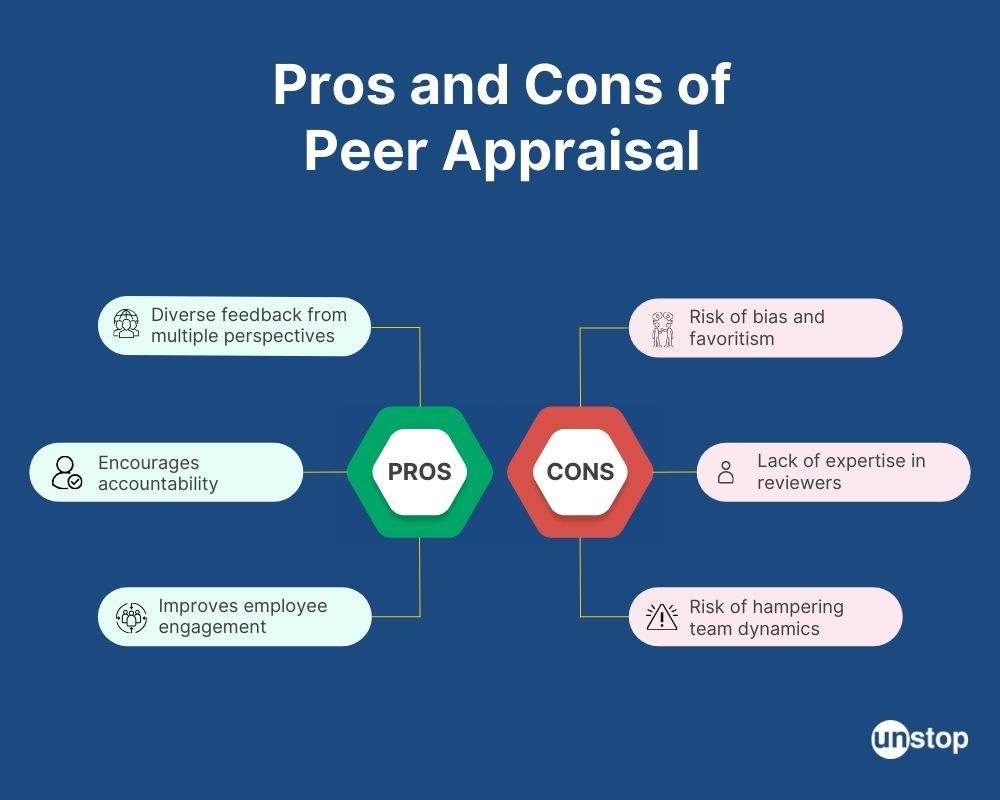- Understanding Peer Appraisal
- Benefits of Peer Appraisal
- Types of Peer Appraisal Methods
- Peer Appraisal: Step-by-Step Process
- Common Challenges of Peer Appraisal
- Implementing Peer Appraisal: Best Practices
- Closing Thoughts
- Frequently Asked Questions
Peer Appraisal: Definition, Types, Benefits & Implementation

In today's dynamic workplace, peer appraisal has emerged as a valuable tool for fostering collaboration, enhancing employee development, and promoting a culture of continuous improvement.
Beyond the traditional manager-employee evaluation, peer appraisal offers a unique perspective on performance, tapping into the insights of colleagues who work closely with individuals. This article will delve into the significance of peer appraisal, its benefits, and practical strategies for successful implementation.
Understanding Peer Appraisal
Definition
Peer appraisal is a performance evaluation process where employees assess the performance of their peers. It provides a 360-degree view of an employee's performance by incorporating feedback from colleagues, subordinates, and supervisors.
This approach can offer valuable insights into an employee's strengths, weaknesses, and contributions to the team, fostering a more collaborative and objective evaluation process.
Exclusion of Supervisors
Excluding supervisors from the evaluation process is significant. It encourages honest feedback. Employees may feel more comfortable sharing their thoughts without fear of repercussions. This leads to more accurate assessments. Colleagues can provide insights that supervisors might overlook.
Continuous Improvement
Peer appraisal plays a vital role in fostering a culture of continuous improvement. It helps identify strengths and weaknesses among team members. Constructive feedback can lead to personal growth and better teamwork. Employees learn from each other, which enhances overall performance.
Benefits of Peer Appraisal
Enhances Review Accuracy
Peer insights provide a more holistic view of performance. They help identify strengths and weaknesses that management might overlook. With multiple perspectives, biases are reduced. This leads to fairer evaluations. Peers can spot skills and competencies not visible to higher-ups.
Promotes Task Accountability
Feedback from peers encourages ownership of roles. Individuals feel responsible for their contributions. This sense of accountability boosts overall team performance. When team members know they will receive feedback, they strive to perform better. Constructive criticism drives both personal and team growth.
Encourages Employee Recognition
Peer appraisal highlights individual contributions and achievements. Recognizing efforts can significantly improve employee morale. When people feel valued, they are more motivated to excel. Peer feedback fosters a supportive work environment where everyone feels appreciated.
Also Read: How Rewards & Recognition Boost Employee Productivity
Boosts Team Dynamics
Peer appraisal promotes open communication and collaboration among team members. It fosters mutual respect and understanding, which enhances team performance. Regular feedback exchanges strengthen relationships within the group. Improved dynamics lead to a more cohesive and productive team.
Types of Peer Appraisal Methods
Peer appraisal methods involve employees evaluating their colleagues' performance. These methods help assess collaboration, teamwork, and individual contributions from a peer perspective. Here are some common methods:
1. Peer Review Surveys
Peers complete structured surveys or questionnaires about a colleague's performance, skills, or behavior. This method provides quantifiable data based on different performance metrics.
2. 360-Degree Feedback
A comprehensive review process where feedback is collected from peers, supervisors, subordinates, and sometimes customers. This holistic approach provides diverse insights into an employee's overall performance.
3. Narrative Feedback
Peers provide detailed written feedback on specific strengths, weaknesses, and contributions of the employee. This allows for a more personalized assessment, with examples and constructive criticism.
4. Group Appraisal
In team-based environments, peers evaluate each other collectively. Each team member discusses the performance of their colleagues in a group setting, encouraging open communication and transparency.
5. Peer Ranking
Employees rank each other’s performance within a team. This method can create competition but also identifies top performers. It works best in highly competitive or sales-driven environments.
6. Behavioral Anchored Rating Scales (BARS)
Peers rate colleagues based on specific behaviors that align with job performance. The BARS method ensures that feedback is tied to observable actions rather than subjective opinions.
7. Competency-Based Peer Assessment
Peers assess each other based on job-specific competencies. This competency assessment ensures evaluations are relevant to the skills needed for the role and provides targeted feedback on key areas.
Each method has its advantages, but they should be carefully implemented to avoid bias and ensure constructive, honest feedback.
Peer Appraisal: Step-by-Step Process

The peer appraisal process typically involves several steps designed to gather, analyze, and implement feedback from colleagues. Here’s an overview of the process:
1. Preparation and Setup
- Define Objectives: Clarify the goals of the peer appraisal process. Is it for development, performance evaluation, or team improvement?
- Choose the Method: Select the peer appraisal method that best suits the organization’s needs (e.g., 360-degree feedback, surveys, or narrative reviews).
2. Selection of Peers
- Identify Relevant Peers: Determine which colleagues are in the best position to provide meaningful feedback. This is often based on working relationships, collaboration frequency, or project involvement.
- Set Criteria for Evaluation: Provide evaluators with clear guidelines on what aspects of performance to assess (e.g., communication, teamwork, job-specific skills).
3. Designing the Feedback Tool
- Create Structured Forms: Develop surveys, questionnaires, or other feedback tools that are standardized, ensuring fairness and consistency.
- Include Both Qualitative and Quantitative Questions: Use a mix of rating scales (e.g., 1-5) and open-ended questions for a comprehensive evaluation.
4. Data Collection
- Gather Feedback Anonymously: To encourage honest responses, ensure that feedback is collected confidentially, often through an online platform.
- Provide Clear Instructions: Ensure that evaluators understand the process, criteria, and importance of providing constructive feedback.
5. Data Analysis and Interpretation
- Analyze Results: Consolidate the feedback to identify trends, strengths, and areas for improvement. This could be done by HR, team leaders, or an external consultant.
- Focus on Constructive Insights: Highlight key areas that require attention while recognizing positive performance. Balance critical feedback with praise.
6. Feedback Delivery
- Provide Feedback to Employees: Share the results of the peer appraisal with the employee. This can be done through one-on-one meetings with supervisors or through self-reflection sessions.
- Encourage Self-Assessment: Employees should be given a chance to reflect on the feedback and discuss how it aligns with their self-perception.
7. Action Plan Development
- Set Goals for Improvement: Based on the feedback, create an action plan for personal or team development. This may involve setting new goals, attending training, or making changes in work habits.
- Support with Resources: Offer resources such as mentoring, coaching, or professional development programs to help employees act on the feedback.
8. Follow-up and Review
- Monitor Progress: Regularly check in on how employees are applying feedback and progressing toward their goals.
- Adjust as Needed: Modify goals or the appraisal process based on outcomes and ongoing evaluations.
By following these steps, peer appraisals can lead to better team dynamics, enhanced performance, and professional development.
Common Challenges of Peer Appraisal
Peer appraisal can present several common challenges that need to be addressed effectively to ensure a fair and constructive evaluation process.
1. Social Biases:
- Friendship Bias: Employees may rate their friends or colleagues more favorably.
- Halo Effect: Positive or negative perceptions of one aspect of an employee's performance can influence ratings of other areas.
- Leniency or Severity Bias: Employees may be overly lenient or harsh in their ratings.
2. Lack of Objectivity:
- Personal Opinions: Peer appraisals can be influenced by personal opinions and biases.
- Limited Perspective: Employees may have limited visibility into their peers' work, leading to inaccurate assessments.
3. Resistance to Change:
- Fear of Conflict: Employees may be reluctant to provide negative feedback to their peers, fearing conflict or retaliation.
- Lack of Trust: If there is a lack of trust among team members, peer appraisal can be ineffective.
4. Time-Consuming:
-
Workload: Conducting and analyzing peer appraisals can be time-consuming for both employees and managers.
5. Confidentiality Concerns:
- Privacy: Ensuring confidentiality and anonym to provide honest feedback if they fear negative repercussions.
To address these challenges, organizations should implement clear guidelines, provide training, and foster a culture of open communication and trust. By addressing these common challenges proactively, organizations can enhance the effectiveness and fairness of their peer appraisal processes.
Implementing Peer Appraisal: Best Practices

Integration Steps
Integrating peer appraisal into existing performance evaluations requires a clear plan. Start by identifying the strengths of your current system. Gather input from employees about how peer feedback can enhance their work experience. Next, establish a timeline for implementation. This includes setting deadlines for training and feedback collection.
Training Importance
Training is crucial for success. Employees need guidance on how to give and receive feedback effectively. Workshops can help them understand the value of constructive criticism. These sessions should focus on communication skills and emotional intelligence. Employees will feel more confident in sharing their thoughts. This confidence leads to better teamwork and collaboration.
Clear Guidelines
Clear guidelines ensure fairness and consistency in the peer appraisal process. Outline what types of feedback are appropriate. Specify how often appraisals should occur and who will participate. Ensure everyone understands the criteria for evaluation. This transparency builds trust among team members. It also helps prevent misunderstandings or biases during evaluations.
Closing Thoughts
Peer appraisal is a powerful tool that can enhance team dynamics and boost performance. By understanding its methods, benefits, and effective strategies, you can create a more engaged and productive work environment. This approach fosters collaboration and accountability among peers while providing valuable feedback that drives professional growth.
With peer appraisal, start small, gather feedback, and refine your process to see the positive impact on morale and productivity.
Frequently Asked Questions
1. What is peer appraisal?
Peer appraisal is a performance evaluation method where colleagues assess each other's work. It promotes collaboration and provides diverse perspectives on individual contributions.
2. Why is peer appraisal important?
Peer appraisal fosters accountability and encourages open communication among team members. It enhances team dynamics and helps identify strengths and areas for improvement.
3. What are the types of peer appraisal methods? (REREAD)
Common methods include 360-degree feedback, self-assessment paired with peer review, and structured rating scales. Each method offers unique insights into performance.
4. How can peer appraisal benefit employees?
It boosts morale, enhances professional development, and improves job satisfaction. Employees receive constructive feedback that aids personal growth and skill enhancement.
5. How do you implement peer appraisal effectively?
Start with clear guidelines, provide training, and ensure anonymity if needed. Regularly review the process to adapt to team needs and maintain fairness.
6. What challenges might arise with peer appraisal?
Potential challenges include bias, lack of trust among peers, and unclear criteria. Address these issues through transparency and clear communication to ensure effectiveness.
7. Can peer appraisal be used in all workplaces?
Yes, peer appraisal can be adapted for various environments. However, its success depends on company culture and the willingness of employees to participate openly.
Suggested Reads:
- Background Checks For Employment: Importance, Types & Compliance
- Social Enterprise: Meaning, Examples, Essential Considerations
- Budget 2024: Key Takeaways for Employment Sector That HRs Must Know!
- Non-Monetary Benefits: 15+ Incentives To Boost Employee Engagement
- HR Glossary | 140+ Terms Every HR Professional Must Know
I’m a reader first and a writer second, constantly diving into the world of content. If I’m not writing or reading, I like watching movies and dreaming of a life by the beach.
Login to continue reading
And access exclusive content, personalized recommendations, and career-boosting opportunities.
Subscribe
to our newsletter
Blogs you need to hog!

Organize Hackathons: The Ultimate Playbook With Past Case Studies

What is Campus Recruitment? How To Tap The Untapped Talent?

Lateral Hiring: A Complete Guide To The Process, Its Benefits, Challenges & Best Practices













Comments
Add comment